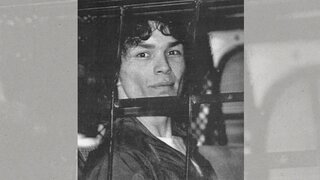Create a free profile to get unlimited access to exclusive videos, breaking news, sweepstakes, and more!
How Did Richard Ramirez's 'Absolutely Disgusting, Rotted Teeth' Factor Into His Capture And Conviction?
The serial killer known as the "Night Stalker" had dental issues that proved to be more than just a toothache — they helped lead to his conviction.

As California investigators hunted for the so-called “night stalker” in the mid-1980s, many elements and clues led to the eventual capture of Richard Ramirez — but it was the serial killer’s teeth that stood out as one of the more jarring details in the manhunt.
From June 1984 until August 1985, Ramirez terrorized California by orchestrating what, at first, appeared to random violent crimes. He would break into homes and assault residents, sometimes kidnapping and molesting children and then letting them free. In other attacks, he’d rape and kill adults, but it was the seeming randomness of his crimes that made for an unprecedented modus operandi. Not only did he vary in his victim profile — they ranged in age, gender and race — but he was all over the place with his choice of weapons, which ranged from knives and guns to blunt objects.
“Never before in criminal history had a single killer been responsible for such a grisly array of crimes,” Netflix stated in a press release teasing their new docuseries, “Night Stalker: The Hunt for a Serial Killer,” which is available Wednesday.
The series details how Los Angeles County Sheriff's Department detectives — Gil Carrillo and Frank Salerno, in particular — put the pieces together. While disbelieved at first, Carrillo’s hypothesis that the crimes were the work of one man ultimately proved to be true.
Before the elusive killer was identified, detectives were able to determine that footprints left at the scenes could be linked back to a particular uncommon Avia brand shoe. They were able to figure out that only one person in Los Angeles owned this particular model in that particular size. But, as the series notes, it was Ramirez’s teeth that also played a big role during the detectives’ quest to identify the killer.
After all, rotting teeth became a constant and consistent detail in witness descriptions. Ester Petschar observed Ramirez buying an AC/DC hat, which was later left at a crime scene, at a thrift store, then ran into him on the freeway afterward. She said his grin, which was full of missing teeth, made him look like a “killer clown.”
Glen Creaso was working as a librarian at the Los Angeles Public Library when Ramirez walked in, and he recalled that the killer had “absolutely disgusting, rotted teeth.” Adults and kids alike described him as having “brown-stained gapped teeth,” Carrillo explains in the docuseries.
During the summer of 1985, more than 100 days into Ramirez’s crime spree, he ran off after he was stopped in a stolen car. Inside that vehicle, detectives located a business card from a Chinatown dental office. Carrillo and Salerno interviewed the dentist, who told them that the suspect was just in for a dental appointment. X-rays showed that he had an impacted tooth, so the detectives expected he’d be back for more work soon.
That’s what the department placed two of their own detectives in the waiting room to survey the dental office, in case the suspect came back for a follow-up appointment. They were told it was a waste of money from someone in their department, so days later they installed an alarm, which, in theory, allowed the dentist to alert the police immediately if the suspect came in for more dental work. However, the very day that the detectives were removed from the dental office, Ramirez returned. The alarm also malfunctioned and the investigators missed their chance.
While Ramirez’s teeth were not the ultimate clue that brought him down, they did come into play during his trial. Three dentists gave testimony about Ramirez’s teeth during the proceeding, according to a 1989 Associated Press report. Not only did their testimony assure jurors that Ramirez had dental issues, which proved he was a match to witness descriptions, but it refuted at least one alibi. Ramirez’s father had told investigators that his son had been back in El Paso, Texas during a one-week time span in which three Los Angeles attacks occurred. However, one of the dentists testified that he treated Ramirez at his Los Angeles office during that time, exploding that alibi.
The jury apparently agreed with the testimony and sentenced Ramirez to death. He died in 2013 of lymphoma behind bars as he awaited his execution.


























